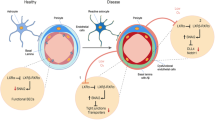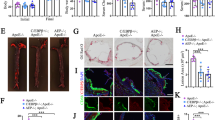Abstract
Amyloid β-peptide (Aβ) deposition in cerebral vessels contributes to cerebral amyloid angiopathy (CAA) in Alzheimer's disease (AD). Here, we report that in AD patients and two mouse models of AD, overexpression of serum response factor (SRF) and myocardin (MYOCD) in cerebral vascular smooth muscle cells (VSMCs) generates an Aβ non-clearing VSMC phenotype through transactivation of sterol regulatory element binding protein-2, which downregulates low density lipoprotein receptor-related protein-1, a key Aβ clearance receptor. Hypoxia stimulated SRF/MYOCD expression in human cerebral VSMCs and in animal models of AD. We suggest that SRF and MYOCD function as a transcriptional switch, controlling Aβ cerebrovascular clearance and progression of AD.
This is a preview of subscription content, access via your institution
Access options
Subscribe to this journal
Receive 12 print issues and online access
$209.00 per year
only $17.42 per issue
Buy this article
- Purchase on SpringerLink
- Instant access to full article PDF
Prices may be subject to local taxes which are calculated during checkout








Similar content being viewed by others
References
Iadecola, C. Neurovascular regulation in the normal brain and in Alzheimer's disease. Nature Rev. Neurosci. 5, 347–360 (2004).
Zlokovic, B. V. The blood-brain barrier in health and chronic neurodegenerative disorders. Neuron 57, 178–201 (2008).
Tanzi, R. E., Moir, R. D. & Wagner, S. L. Clearance of Alzheimer's Aβ peptide: the many roads to perdition. Neuron 43, 605–608 (2004).
Haass, C. & Selkoe, D. J. Soluble protein oligomers in neurodegeneration: lessons from the Alzheimer's amyloid β-peptide. Nature Rev. Mol. Cell Biol. 8, 101–112 (2007).
Greenberg, S. M., Gurol, M. E., Rosand, J. & Smith, E. E. Amyloid angiopathy-related vascular cognitive impairment. Stroke 35, 2616–2619 (2004).
Jellinger, K. A. Alzheimer disease and cerebrovascular pathology: an update. J. Neural Transm. 109, 813–836 (2002).
Pettersen, J. A. et al. Microbleed topography, leukoaraiosis, and cognition in probable Alzheimer disease from the Sunnybrook Dementia Study. Arch. Neurol. 65, 790–795 (2008).
Zlokovic, B. V., Yamada, S., Holtzman, D., Ghiso, J. & Frangione, B. Clearance of amyloid beta-peptide from brain: transport or metabolism? Nature Med. 6, 718–719 (2000).
Selkoe, D. J. Clearing the brain's amyloid cobwebs. Neuron 32, 177–180 (2001).
Holtzman, D. M. & Zlokovic, B. V. Role of Aβ transport and clearance in the pathogenesis and treatment of Alzheimer's disease. In Alzheimer's Disease: Advances in Genetics, Molecular and Cellular Biology. (eds Sisodia, S. S., Tanzi, R. E.) pp. 179–198 (Springer, New York, 2007)
Davis, J. et al. Early-onset and robust cerebral microvascular accumulation of amyloid β-protein in transgenic mice expressing low levels of a vasculotropic Dutch/Iowa mutant form of amyloid β-protein precursor. J. Biol. Chem. 279, 20296–20306 (2004).
Deane, R. et al. LRP/amyloid β-peptide interaction mediates differential brain efflux of Aβ isoforms. Neuron 43, 333–344 (2004).
Kumar-Singh, S. et al. Dense-core plaques in Tg2576 and PSAPP mouse models of Alzheimer's disease are centered on vessel walls. Am. J. Pathol. 167, 527–543 (2005).
Shibata, M. et al. Clearance of Alzheimer's amyloid-ss(1–40) peptide from brain by LDL receptor-related protein-1 at the blood-brain barrier. J. Clin. Invest. 106, 1489–1499 (2000).
Moir, R. D. & Tanzi, R. E. LRP-mediated clearance of Aβ is inhibited by KPI-containing isoforms of APP. Curr. Alzheimer Res. 2, 269–273 (2005).
Bell R. D. et al. Transport pathways for clearance of human Alzheimer's amyloid beta-peptide and apolipoproteins E and J in the mouse central nervous system. J. Cereb. Blood Flow Metab. 27, 909–918 (2007).
Nazer, B., Hong, S. & Selkoe, D. J. LRP promotes endocytosis and degradation, but not transcytosis, of the amyloid-β peptide in a blood-brain barrier in vitro model. Neurobiol. Dis. 30, 94–102 (2008).
Urmoneit, B. et al. Cerebrovascular smooth muscle cells internalize Alzheimer amyloid β protein via a lipoprotein pathway: implications for cerebral amyloid angiopathy. Lab. Invest. 77, 157–166 (1997).
Miano, J. M. Serum response factor: toggling between disparate programs of gene expression. J. Mol. Cell. Cardiol. 35, 577–593 (2003).
Wang, D. et al. Activation of cardiac gene expression by myocardin, a transcriptional cofactor for serum response factor. Cell 105, 851–862 (2001).
Pipes, G. C., Creemers, E. E. & Olson, E. N. The myocardin family of transcriptional coactivators: versatile regulators of cell growth, migration, and myogenesis. Genes Dev. 20, 1545–1556 (2006).
Chow, N. et al. Serum response factor and myocardin mediate arterial hypercontractility and cerebral blood flow dysregulation in Alzheimer's phenotype. Proc. Natl Acad. Sci. USA. 104, 823–828 (2007).
Brown, M. S. & Goldstein, J. L. The SREBP pathway: regulation of cholesterol metabolism by proteolysis of a membrane-bound transcription factor. Cell 89, 331–340 (1997).
Llorente-Cortés, V., Costales, P., Bernués, J., Camino-Lopez, S. & Badimon, L. Sterol regulatory element-binding protein-2 negatively regulates low density lipoprotein receptor-related protein transcription. J. Mol. Biol. 359, 950–960 (2006).
Llorente-Cortés, V., Royo, T., Otero-Viñas, M., Berrozpe, M. & Badimon, L. Sterol regulatory element binding proteins downregulate LDL receptor-related protein (LRP1) expression and LRP1-mediated aggregated LDL uptake by human macrophages. Cardiovasc. Res. 74, 526–536 (2007).
Wyss-Coray, T. et al. Adult mouse astrocytes degrade amyloid-β in vitro and in situ. Nature Med. 9, 453–457 (2003).
Miano J. M. et al. Restricted inactivation of serum response factor to the cardiovascular system. Proc. Natl Acad. Sci. USA. 101, 17132–17137 (2004).
Parlakian, A. et al. Targeted inactivation of serum response factor in the developing heart results in myocardial defects and embryonic lethality. Mol. Cell. Biol. 24, 5281–5289 (2004).
Niu, Z. et al. Conditional mutagenesis of the murine serum response factor gene blocks cardiogenesis and the transcription of downstream gene targets. J. Biol. Chem. 280, 32531–32538 (2005).
Donahue, J. E. et al. RAGE, LRP-1, and amyloid-β protein in Alzheimer's disease. Acta. Neuropathol. 112, 405–415 (2006).
Wu, Z., et al. Role of the MEOX2 homeobox gene in neurovascular dysfunction in Alzheimer disease. Nature Med. 11, 959–965 (2005).
Li, S., Wang, D. Z., Wang, Z., Richardson, J. A. & Olson, E. N. The serum response factor coactivator myocardin is required for vascular smooth muscle development. Proc. Natl Acad. Sci. USA. 100, 9366–9370 (2003).
Zhang, X. et al. Cardiomyopathy in transgenic mice with cardiac-specific overexpression of serum response factor. Am. J. Physiol. Heart Circ. Physiol. 280, H1782–H1792 (2001).
Holtzman, D. M. et al. Apolipoprotein E facilitates neuritic and cerebrovascular plaque formation in an Alzheimer's disease model. Ann. Neurol. 47, 739–747 (2000).
Long, X., Creemers, E. E., Wang, D. Z., Olson, E. N. & Miano, J. M. Myocardin is a bifunctional switch for smooth versus skeletal muscle differentiation. Proc. Natl Acad. Sci. USA. 104, 16570–16575 (2007).
Alberti, S. et al. Neuronal migration in the murine rostral migratory stream requires serum response factor. Proc. Natl. Acad. Sci. USA. 102, 6148–6153 (2005).
Etkin, A. et al. A role in learning for SRF: deletion in the adult forebrain disrupts LTD and the formation of an immediate memory of a novel context. Neuron 50, 127–143 (2006).
Herz, J. & Marschang, P. Coaxing the LDL receptor family into the fold. Cell 112, 289–292 (2003).
Herring, A. et al. Environmental enrichment counteracts Alzheimer's neurovascular dysfunction in TgCRND8 Mice. Brain Pathol. 18, 32–39 (2008).
Sagare, A. et al. Clearance of amyloid-β by circulating lipoprotein receptors. Nature Med. 13, 1029–1031 (2007).
Sato, R. et al. Assignment of the membrane attachment, DNA binding, and transcriptional activation domains of sterol regulatory element-binding protein-1 (SREBP-1). J. Biol. Chem. 269, 17267–17273 (1994).
Yang, J., Brown, M. S., Ho, Y. K. & Goldstein, J. L. Three different rearrangements in a single intron truncate sterol regulatory element binding protein-2 and produce sterol-resistant phenotype in three cell lines. J. Biol. Chem. 270, 12152–12161 (1995).
Kellman, W., Ruosseau, P., Celesia, G. G., Siegel, G. Decreased prevalence of Alzheimer disease associated with 3-hydroxy-3-methyglutaryl coenzyme A reductase inhibitors. Arch. Neurol. 57, 1439–1443 (2000).
Sparks, D. L. et al. Atorvastatin for the treatment of mild to moderate Alzheimer disease: preliminary results. Arch. Neurol. 62, 753–757 (2005).
Deane, R., Wu, Z. & Zlokovic, B. V. RAGE (yin) versus LRP (yang) balance regulates alzheimer amyloid β-peptide clearance through transport across the blood-brain barrier. Stroke. 35, 2628–2631 (2004).
Puglielli, L. et al. Acyl-coenzyme A: cholesterol acyltransferase modulates the generation of the amyloid β-peptide. Nature Cell Biol. 3, 905–912 (2001).
Parsons, R. B. et al. Statins inhibit the dimerization of β-secretase via both isoprenoid- and cholesterol-mediated mechanisms. Biochem. J. 399, 205–214 (2006).
Vermeer, S. E. et al. Silent brain infarcts and the risk of dementia and cognitive decline. N. Engl. J. Med. 348, 1215–1222 (2003).
Ruitenberg, A. et al. Cerebral hypoperfusion and clinical onset of dementia: the Rotterdam Study. Ann. Neurol. 57, 789–794 (2005).
Zhu, P., Huang, L., Ge, X., Yan, F., Wu, R. & Ao, Q. Transdifferentiation of pulmonary arteriolar endothelial cells into smooth muscle-like cells regulated by myocardin involved in hypoxia-induced pulmonary vascular remodeling. Int. J. Exp. Pathol. 87, 463–474 (2007).
Acknowledgements
We thank Ms. Theresa Barrett for assisting with some immunostaining studies. This study was supported by R37AG023084, R37NS34467 and Socratech LLC to BVZ, 1R43 AG02400 to NC and HL62572 and R42AG026950 to JMM. JMM and BVZ are co-senior authors.
Author information
Authors and Affiliations
Contributions
R.D.B. contributed to project planning, performed in vitro experiments with human VSMCs, ex vivo western blotting and immunostaining studies, in vivo 2-photon imaging, and data analysis; R.D. contributed to project planning and performed in vivo adenoviral gene transfers; N.C. contributed to in vitro experiments and project planning; X.L. developed and performed luciferase reporter assays and data analysis; A.S. performed all ELISA experiments and data analysis; I.S. participated in project planning; J.W.S. developed adenoviral constructs; H.G. assisted with immunostaining; A.R. helped with obtaining human tissue for VSMC isolation and provided neuropathological analysis; W.V.N. provided Dutch/Iowa APP mice and isolated VSMCs; J.M.M. participated in project planning and manuscript editing, and provided expertise on SRF and MYOCD; B.V.Z. designed the entire study, supervised all parts of the study and wrote the manuscript.
Corresponding author
Ethics declarations
Competing interests
B.V.Z. is the scientific founder of Socratech L.L.C., a startup biotechnology company with a mission to develop neuroprotective strategies in the ageing brain and for brain disorders such as stroke and Alzheimer's disease. J.M.M. and B.V.Z. are inventors on SRF and MYOCD patent pending application.
Supplementary information
Supplementary Information
Supplementary Information (PDF 923 kb)
Rights and permissions
About this article
Cite this article
Bell, R., Deane, R., Chow, N. et al. SRF and myocardin regulate LRP-mediated amyloid-β clearance in brain vascular cells. Nat Cell Biol 11, 143–153 (2009). https://doi.org/10.1038/ncb1819
Received:
Accepted:
Published:
Issue Date:
DOI: https://doi.org/10.1038/ncb1819



